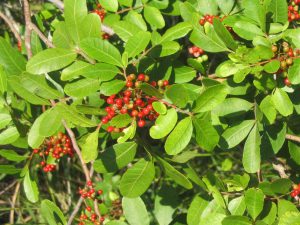Licensed pesticide applicators know the importance of identifying potential pest and disease issues before they apply any type of pesticide, including an herbicide. Pest identification is always the first step in Integrated Pest Management, one of the key principles of Florida-Friendly LandscapingTM.
Why Plant ID is important
Knowing the names of the plants in the landscape or natural area helps landscapers, pesticide applicators, homeowners, and others differentiate between pest plants and desirable p lants. You may think telling pests and desirable plants apart is easy, but not always so! Some of our worst pest plants, known as “invasives”, started out here as ornamental plants. One example is Brazilian pepper (pictured here), which was introduced to Florida as a landscape plant, referred to as “Florida holly”. Every year, the state spends a lot of money trying to keep invasive plants from over-taking the natural habitats in our parks and preserves. We can help by learning about the plants in our landscapes and actively removing invasive plants. Licensed green industry professionals, like landscapers and pesticide applicators, learn about plants so they can do the work of managing landscapes, while protecting the environment and educating their clients.
lants. You may think telling pests and desirable plants apart is easy, but not always so! Some of our worst pest plants, known as “invasives”, started out here as ornamental plants. One example is Brazilian pepper (pictured here), which was introduced to Florida as a landscape plant, referred to as “Florida holly”. Every year, the state spends a lot of money trying to keep invasive plants from over-taking the natural habitats in our parks and preserves. We can help by learning about the plants in our landscapes and actively removing invasive plants. Licensed green industry professionals, like landscapers and pesticide applicators, learn about plants so they can do the work of managing landscapes, while protecting the environment and educating their clients.
If I know it’s a weed, why do I need to know more?
One of the nine Florida-Friendly LandscapingTM principles is to “Manage Yard Pests Responsibly“, using Integrated Pest Management (IPM). The goal of IPM is to “prevent and manage pest problems with as few chemicals as possible”. A key first step with IPM is to identify the pest and learn about it. In the case of pest plants, or weeds, some key things we can learn are:
- Is this plant a perennial or an annual? Most annuals reproduce primarily by seed and live less than a year. If we see an annual in bloom, we know it’s about to set seed and likely complete its life cycle, so there is no need to apply a pesticide to kill the plant. If we have a perennial weed, we know that even if we hand-pull the plant, it may re-sprout from underground plant parts (root fragments, tubers, etc.).
- Is the weed a grass, sedge, or broad-leaf plant? Some herbicides are specific to broad-leaved weeds or grassy weeds, for example, so knowing the plant type can help us select the right product to use.
- What site conditions could be encouraging the weed to grow? Does the weed prefer moist soils? If so, cutting back on irrigation could help. Is the weed a shade-loving plant, thriving because the site doesn’t receive enough sunlight for grass to do well? In that case, replacing the grass with mulch or a shade-tolerant groundcover could solve the problem.
To learn more about managing weeds in Florida lawns and gardens, the UF Electronic Data Information Source (EDIS) topic area, Weeds and Weed Management in Lawn, Landscape, and Garden offers science-based guidance for homeowners and green industry professionals.
Where to find help identifying plants
UF/IFAS Extension is here to help. UF/IFAS Extension County Agents help green industry professionals identify plants. UF/IFAS Extension County Master Gardener volunteers can help homeowners with their plant identification needs. Local offices are also supported in their plant ID efforts by the UF Herbarium’s Extension Botanist, Marc Frank. Reach out to your local UF/IFAS Extension County office for assistance. Most offices will accept either emailed photographs or physical samples of plants for identification. For tips in taking good quality images for plant identification, check out the blog “Contact-free Plant ID: Collecting Good Quality Images”.
If you would like to learn some common plants on your own, the UF/IFAS Bookstore offers a variety of plant identification decks and books for online purchase and delivery. One good example is the “Identification Guide to Common Florida Lawn and Ornamental Weeds”. Other guides cover trees, wildflowers, shrubs and vines, and more.
Thanks to Marc Frank, UF/IFAS Extension Botanist, and Jennifer Pelham, Martin County Extension Director and Urban Horticulture Agent, for their contributions to this article.
 0
0
